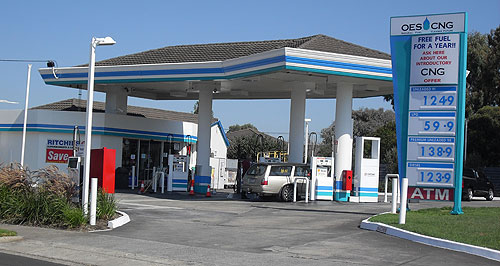News - General NewsAussie company set to launch home CNG fillerHome too: CNG vehicle owners will be able to opt for home refueling as well as public filling. CNG refueling rollout set to include more service stations and home compressors28 Jul 2010 THE company that opened Australia’s first full public access compressed natural gas (CNG) service station in April is also in the final stages of developing a home refueling unit that should hit the market in the second quarter of 2011. Melbourne-based OES CNG says the home compressor will complement its public refueling station network, which it is planning to roll out at the rate of four sites a year, starting in Victoria. OES CNG general manager Kevin Black told this week’s Society of Automotive Engineers Australasia (SAE-A) gaseous fuels conference in Melbourne that the company had developed its own home compressor unit after looking at others available overseas. “The final testing will be done in the next few weeks to make sure the controls are totally idiot proof,” he said. “We expect to submit it for regulatory approval before October.” Like the home compressor, OES CNG also went it alone on its SmartGas refueling station roll out after meeting resistance from established oil companies and nervousness from small independent operators who did not want to go first.  Left: OES CNG's home filling unit. Left: OES CNG's home filling unit.The company bought a petrol station in the southern Melbourne suburb of Aspendale Gardens, on the doorstep of the Braeside light industrial district, which was a likely source of customers, particularly tradesmen. Mr Black said a lack of existing official standards and equipment for the pioneering move meant OES had to develop a lot of its own standards and systems, such as an operator console to facilitate customer payment for CNG in kilograms, as well as existing petrol in litres. He said OES even had to buy its own measuring equipment to test the accuracy of the fuel delivery in the presence of weights and measures inspectors because no official systems existed. Mr Black said OES was planning four more such stations in Victoria – three in Melbourne and one in regional Victoria – in the next 12 months, followed by four more a year for the next three years. He said the company was also looking at joint ventures interstate, with projects on the cards for Adelaide, Perth, Sydney and the Gold Coast. As GoAuto has reported, three other public CNG refuelling stations exist in Australia – two in NSW (Sydney and Goulburn) and one in Canberra – that require a specific account with ACT-based energy utility ActewAGL. The difference with the OES station in Victoria is that customers need no account or special access, simply filling up and paying for fuel by cash or credit card as they would for petrol, diesel or LPG. Mr Black said a lack of national regulations on gas cylinder checks needed to be addressed for safety reasons, in case the units passed their use-by date. He said that while NSW required gas-vehicle cylinder checks with regular roadworthiness checks, Victorian car owners only needed to get a roadworthy when they sold their vehicle, which could leave many vehicle gas cylinders unchecked for many years. To overcome this, OES was planning to fit a radio-enabled identification unit to the cylinder of each first-time customer in Victoria. This would be checked automatically and matched with the use-by date with each fill to prevent out-of-date cylinders being filled, thereby fulfilling OES’s safety responsibility. OES CNG was also working with TAFE colleges to develop CNG installation qualifications for gasfitters, to ensure this high-pressure plumbing was done by expert tradesmen. The Aspendale Gardens installation was done by OES engineers. Mr Black said OES CNG was selling its gas at 72 cents a kilogram, which equated to 55 cents for diesel, 50 cents for petrol and 33 cents for LPG. He said the company was giving a year’s free gas to the first 100 customers to attract business, and so far the system was working well. “We are finding that tradesman with an average ute or van can pay off the conversion in 12 to 14 months, or in four and a half months with free fuel,” he said. Mr Black said the roll out of public refueling stations was important for CNG vehicle owners, even if they had their own compressor at home or workplace, as it allowed greater fleet flexibility. “For this reason, we are extending the public refueling network as rapidly as possibly,” he said.  Read more |
Click to shareGeneral News articlesResearch General News Motor industry news |















Facebook Twitter Instagram